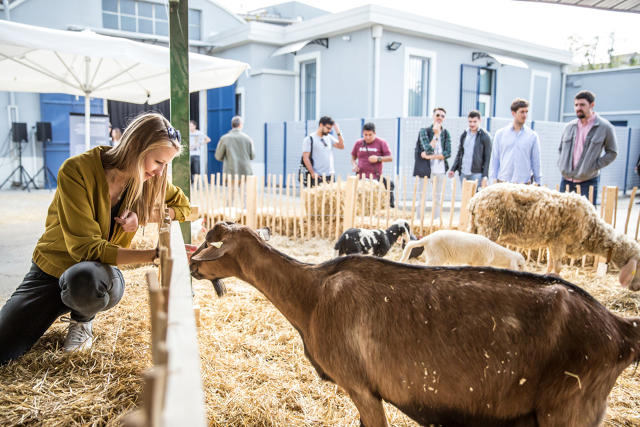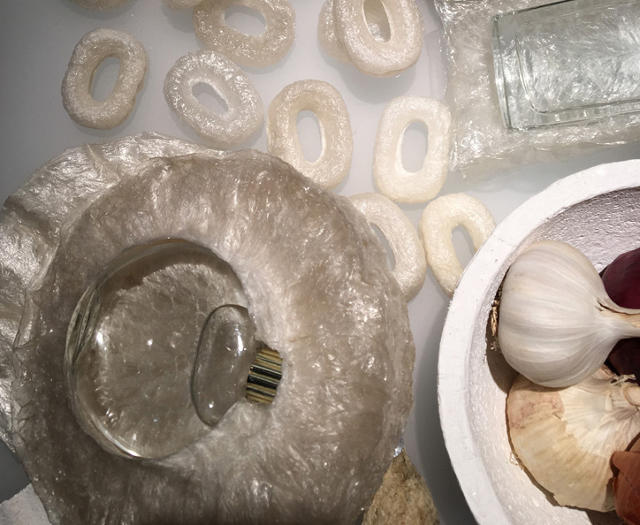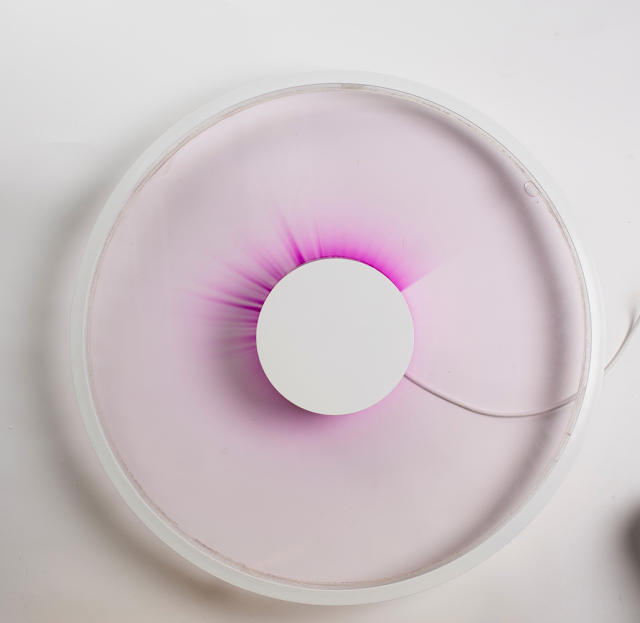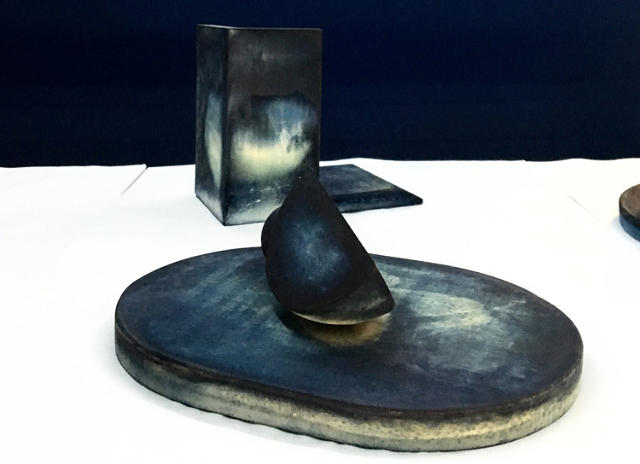In Milan, A Tantalizing Glimpse At The Future Of Your Living Room
Gorgeous furniture is only half of Milan Design Week, the largest, most prestigious design fair of the year. The other half? Head-scratching conceptual projects and design experiments that push the field into the future. Think about interior designs that morph over time, stools made from 3-D printing scraps, and even a petting zoo that stabilizes your mood. We scoured the city to find the best, most cutting-edge designs. Think of this as a guide to the living room of tomorrow.
Studio Ilio Stools

Using waste material from 3-D printing, Studio Ilio made 12 stools in a series called Hot Wire Extensions. The designers formed a shape using wires, then set it into a mold filled with nylon powder taken from companies that use selective laser sintering. Hooking the wires up to an electrical current makes them hot, and they melt the material around them, creating the stools’ final form.
The Living Interior by Belén

Designers Brecht Duijf and Lenneke Langenhuijsen of the Amsterdam-based studio Belén are interested in the material aspects of a space and grapple with how color and texture can evolve over time. Through their experimental materials, they want to give rooms a character of their own and a “soul.” The big-picture idea? If an interior morphs and changes on its own, it can better stand the test of time since people never get bored with it.
Belén uses vegetable-based dyes, which all react to UV radiation differently since some colors are naturally more stable than others. The Laying bag—made from 3-D knitted fabric—is dyed pale pink. The surface will fade to yellow over time while the creases will remain the same hue, creating an ombré effect. A similar treatment takes place with the plush Fluffed rug whose long, wool tufts remain pink while the surface fades. As people walk across the carpet and the fibers move around, the visible color changes.
For the living textures wall, Belén worked with Cottonmix—a manufacturer of cotton-based acoustical spray-foam insulation—and the paint company Riga to create textured walls that “change” color based on how light and shadow play with the surface.
Ripening Rugs by Adrianus Kundert

Dutch designer Adrianus Kundert wondered why products lose value over time and why we apply coating after coating to keep items looking new. His research involves looking at how “gradual erosion” can enhance an item and how age can amp up the beauty of a design. The Ripening rugs are woven with special yarns that fray to reveal different layers. For the follow-up project Trans-Saddles, Kundert uses soft lacquers that crack underneath a hard plastic shell.
Touch Base by Design Academy Eindhoven

Building on its fall 2015 Dutch Design Week exhibition, the Design Academy Eindhoven explored tactility, a sense that curators Ilse Crawford and Thomas Widdershoven, also the academy’s creative director, believe is “too often numbed, neglected, vilified, and sexualized.” In addition to showing garments made from human hair and anxiety-mitigating rugs, they went all out and built a petting zoo with chickens, roosters, lambs, and sheep.
But it wasn’t all folly. The students built a pulse sensor that visitors strap around their finger before petting the animals. The concept highlights an observation that while petting animals can boost our mood, we typically only interact with them on YouTube. After you’re done playing with the animals, the machine prints out a graph of your heart rate. (Unfortunately, it didn’t work for me.)
Body Scapes by Jessica Smarsch
Part performance piece, part digital experiment, part cozy blanket, Body Scapes is designer Jessica Smarsch’s investigation into rituals. For 20 days, she took a walk and recorded her emotional state before and after using a custom software system that would translate bodily movement into a graphic pattern. Smarsch then wove two-sided blankets using the patterns—before the walk on one side and after the walk on the other—as a sort of infographic embodying her state of mind.
Iwan Pol at Envisions

Envisions, a group exhibition, focused on the materials research and experimentation that informed the products of nine different practitioners and studios. Instead of showing the completed work, the installation aimed to put concepts first. Iwan Pol is interested in concrete and its reputation for coldness and austerity. In an aptly named series called Happy Concrete, he played with pigments and texture as a way to change the way the ubiquitous building material is perceived.
Agar Packaging by Amam

Kosuke Araki, Noriaki Maetani, and Akira Muraoka—members of the Japanese design studio Amam—won top honors at the Lexus Design Awards for bio-based packaging called Agar Plasticity. (Materials expert Max Lamb served as their mentor on the project.) Derived from seaweed, the packaging is an environmentally substitute for plastic and can take on a variety of textures and thicknesses.
Trace Clock

Also exhibited at the Lexus Design Awards, the Trace clock by the London-based firm Studio Ayaskan uses lasers and the same UV-sensitive material in Transitions eyeglasses to tell time. Twin sisters and Royal College of Art grads Bike and Begum Ayaskan were inspired by the notion that everything we do in the present impacts the future and felt that, culturally, we’re becoming disconnected with time.
To build the clock, Studio Ayaskan mixed a photochromic material (something that changes color when exposed to light) with mineral oil. Two lasers shine UV light—whose wavelength can be calibrated for different colors—for the hour and second hand. As the second hand cycles around the clock, it leaves a trail of color that fades after about 30 seconds so you become more aware of its path.
Out of the Blue by Studiopepe

The Milan-based firm Studiopepe took a page from history for its exploration of color called Out of the Blue. The sculpture series riffs on cyanotypes, an early photographic process developed in the mid-1800s. The designers brushed ceramic sculptures with a cyanotype solution and exposed them to sunlight. The color contrasts that emerged on the pieces’ surface are based on the lighting condition at the time.
Bobina Chair by Studio Nito

Inspired by thread wrapping around bobbins, designers Nil Atalay and Tobias Juretzek of the newly formed Studio Nito made a furniture series using cotton yarns reinforced with a bio-based resin.
Raw Edges Herringbones

Raw Edges created the prismatic herringbone pattern on its latest furniture collection by repeatedly dipping wood slats into different dyes—a technique commonly used for textiles. Depending on which colors are layered on top of one another, they meld to create different hues while allowing the wood grain to show through.
The Light by Studio ByColor
Washi paper is a traditional material for lanterns (it’s what Isamu Noguchi used for his famous Akari lamps) and designer Kaori Akiyama of Studio ByColor mixes it with Trixial, a moldable textile made from polyester to create table lights.

Patience by WePlus
A very literal take on a clock face, Patience by WePlus uses facial expressions to tell time. One eye represents hours, the other represents minutes, and the mouth relays seconds. It’s illegible and bizarre and mesmerizing.
The Meat Project and the Art of Deception by Atelier Monté

To raise awareness about supermarket food waste, designer Isaac Monté collected expired meat and “decellularized” it using a process used in tissue regeneration research. The process turns the meat into a white, rubbery material that can be molded into different shapes. Monté molded it into pendant lights in the form of Escherichia, a bacteria that causes meat to spoil. He used the same process in a series called the Art of Deception, which strips pig hearts of their cells, leaving the only the structure. Monté then turned them into what he calls “elegant vessels.” Scientists already use a similar technique in research for organ transplantation, and Monté wanted to show how organs can become the next design canvas and how far we can engineer the human body.
(86)














